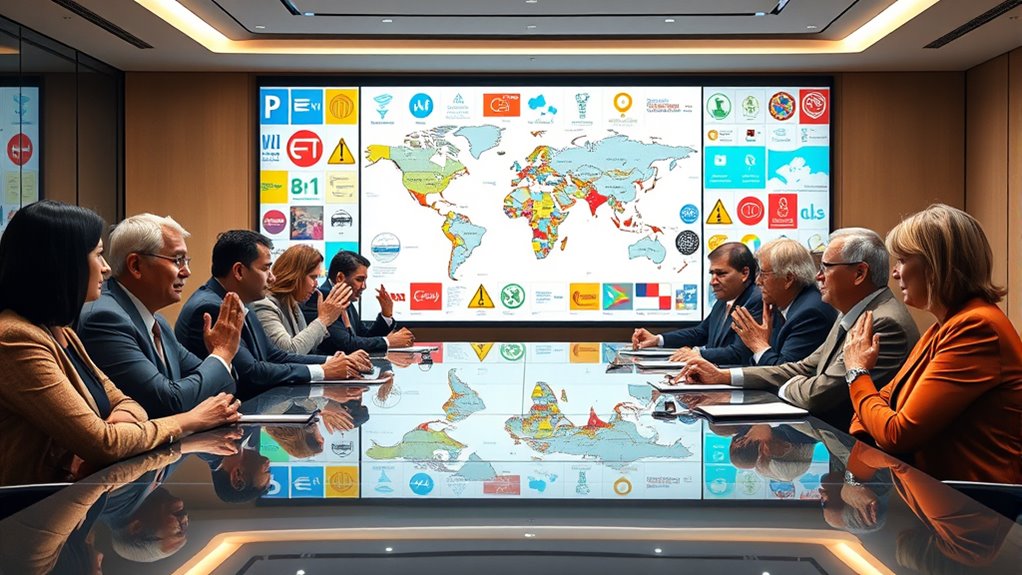The debate over standardizing international sign languages centers on balancing clear global communication with preserving local cultural identities. Advocates argue that a unified system can make communication more accessible and reduce misunderstandings worldwide. However, critics worry that it could erase unique signs rooted in local cultures, risking the loss of linguistic diversity. Considering the complexities involved, exploring the cultural, technological, and community perspectives will help you understand this ongoing conversation better.
Key Takeaways
- Standardization can improve global communication but risks eroding local sign language diversity and cultural identities.
- Cultural norms and regional expressions pose significant barriers to creating a universal sign language.
- Collaborative approaches combining shared signs with regional adaptations promote inclusion and cultural preservation.
- Technological advances facilitate cross-cultural understanding while supporting the maintenance of local sign languages.
- Balancing clarity with respect for cultural differences is essential to address the debate over standardizing International Sign.
The Origins and Development of Sign Languages Worldwide

While the origins of sign languages are diverse, they all share a common foundation in human communication’s natural evolution. Over time, different communities developed their own sign languages, shaped by cultural and social factors, leading to remarkable linguistic diversity. The historical evolution of these languages reveals how they adapted and grew independently, often influenced by neighboring cultures and contact with spoken languages. Despite these differences, they serve similar functions: facilitating communication within deaf communities. You’ll find that each sign language reflects its community’s history, values, and environment. Recognizing this diversity is essential when considering efforts to unify or standardize sign languages, as it highlights both their unique development and shared purpose in human interaction. linguistic diversity underscores the importance of respecting each language’s unique origins and cultural significance.
Arguments Supporting a Unified International Sign System

A unified international sign system can make communication clearer across different countries and cultures. It also encourages greater inclusion by making signs more accessible worldwide. Plus, it simplifies learning signs, helping both new users and experienced signers understand each other more easily. Additionally, standardization can help identify warning signs of strained relationships or misunderstandings early on, fostering healthier interactions.
Enhances Communication Clarity
The use of a standardized international sign system can substantially improve communication clarity across diverse contexts. It reduces misunderstandings, especially when linguistic diversity makes spoken language tricky. With clear, universal signs, you can quickly convey essential information regardless of language barriers. Here’s how it helps:
- Minimizes Confusion: A common set of signs ensures everyone interprets messages the same way.
- Speeds Up Communication: Instant recognition saves time in urgent situations.
- Supports Cultural Preservation: While fostering clarity, standardized signs respect cultural nuances by avoiding language-specific symbols.
- Leverages the world clock utility to synchronize and promote uniform sign usage across regions.
Promotes Global Inclusion
Standardizing international signs fosters greater global inclusion by creating a universal communication tool accessible to everyone, regardless of language or cultural background. This system bridges linguistic diversity, allowing people from different countries to understand each other without language barriers. It promotes equality by providing a common method of communication in international settings like airports, conferences, and tourism. Additionally, it supports cultural preservation by respecting diverse sign languages and gestures, encouraging local communities to maintain their unique communication styles while participating in global interactions. A unified sign system helps break down social and cultural divides, making international travel and cooperation smoother. Implementing a standardized system also benefits from insights into dog names and other cultural identifiers, which can inform more inclusive sign language design. Ultimately, it guarantees that everyone, regardless of their background, can access essential information and participate fully in global activities.
Simplifies Sign Learning
Implementing a unified international sign system makes learning signs much easier for everyone. With gesture simplification, you won’t need to memorize countless unique signs for different languages. Instead, you can focus on a consistent set of gestures that are easily recognizable worldwide. This approach improves sign recognition, making communication faster and more intuitive. Additionally, standardizing signs can incorporate visual clarity, ensuring signs are easily distinguishable and reducing misinterpretation.
Cultural Significance and the Diversity of Local Sign Languages

You might notice that local sign languages carry unique cultural expressions that reflect their communities’ histories and traditions. Preserving these languages helps maintain individual and collective identities, making them more than just communication tools. When considering international standards, it’s important to respect and protect this rich diversity. Recognizing the cultural significance of each sign language further emphasizes the importance of safeguarding their distinctiveness.
Local Cultural Expressions
Local sign languages are rich tapestries woven from the cultural identities and histories of their communities. They serve as powerful tools for cultural expression, capturing unique traditions and beliefs. When you explore local dialects within these signs, you see how they reflect specific social norms and stories. Additionally, self-waterings plant pots demonstrate how design features can enhance plant care by providing consistent moisture levels. Here’s what makes them special: 1. Each sign language embodies local cultural expressions that resonate deeply with its community. 2. Variations in signs highlight regional differences, preserving distinct identities. 3. These dialects evolve alongside cultural shifts, maintaining relevance and authenticity.
Preservation of Identity
Preserving the unique identities embedded in local sign languages is essential for maintaining cultural diversity. When you support the use of local sign languages, you help protect the rich linguistic diversity that reflects each community’s history and traditions. These languages carry cultural meanings beyond mere communication; they embody the identity of their users. Standardizing international sign risks eroding this diversity, potentially leading to cultural homogenization. By valuing local sign languages, you promote cultural preservation and guarantee that future generations can access their cultural heritage. Recognizing the importance of these languages affirms the significance of each community’s unique perspective. In doing so, you contribute to a global environment where linguistic diversity thrives, and cultural identities remain strong and vibrant. Supporting these languages also aligns with efforts to decode fan culture and foster inclusive communities that appreciate diverse expressions of identity.
Technological Advances and Their Role in Global Communication

Technological advances have profoundly transformed how people communicate across borders, making global interaction more seamless than ever before. You now access tools that bridge linguistic diversity and support cultural preservation. These innovations include: 1. Real-time translation apps that break language barriers, helping diverse communities connect effortlessly. 2. Video conferencing platforms enabling sign language users worldwide to communicate visually, maintaining rich cultural expressions. 3. Online platforms that showcase different sign languages, fostering understanding and appreciation of cultural variations. These technologies empower you to engage with global communities without losing sight of linguistic diversity. They also ensure that cultural preservation remains essential amidst rapid communication shifts. As a result, technology plays a fundamental role in shaping inclusive, accessible, and culturally aware international communication. Additionally, home improvement strategies can support the creation of accessible and adaptable environments that cater to diverse communication needs.
Challenges in Creating a Standardized Sign Language

Creating a standardized sign language is a complex challenge because of the diverse cultural and linguistic backgrounds of sign language users worldwide. You face issues like linguistic complexity, where gestures and signs vary greatly, and cultural barriers that influence communication styles. These differences make it difficult to develop a universal system that respects all communities. Here’s an overview of some key challenges:
| Challenge | Explanation |
|---|---|
| Linguistic Complexity | Variations in grammar, vocabulary, and gestures |
| Cultural Barriers | Differing cultural norms and interpretations |
| Regional Differences | Unique signs used in specific areas |
| Adoption Resistance | Reluctance from communities to change established signs |
Additionally, the diversity of water-based activities reflects the importance of tailored communication methods to accommodate different regional practices and preferences.
The Impact on Deaf Communities and Cultural Identity

Standardizing international sign language can substantially impact deaf communities by influencing their cultural identity and sense of belonging. You might see that it affects cultural preservation and the rich linguistic diversity that defines different communities. Here are three key ways this impact unfolds:
- Loss of Unique Expressions: Standardization risks eroding distinct signs rooted in local cultures, threatening cultural preservation.
- Reduced Cultural Identity: When communities adopt a unified sign system, they may feel their unique cultural expressions diminish.
- Simplification of Language Variations: Linguistic diversity could decline, making the language less adaptable to specific cultural contexts.
While a common sign language might improve international communication, it could also weaken the cultural fabric that makes each deaf community unique.
Case Studies: Successful and Failed Attempts at Standardization

Throughout history, efforts to standardize sign languages have yielded both notable successes and significant failures, revealing the complexities involved in unifying diverse linguistic communities. Some initiatives, like the development of simplified international signs for diplomatic use, achieved limited acceptance but struggled with linguistic divergence across cultures. These attempts often overlooked the importance of cultural preservation, leading to resistance from local deaf communities who saw their unique signs and traditions threatened. Conversely, successful collaborations, such as regional standardizations, show that combining shared elements with local adaptations can respect cultural differences while promoting mutual understanding. These case studies highlight that while standardization aims for clarity, it must carefully balance linguistic convergence with the preservation of cultural identity to avoid alienating communities.
Future Perspectives: Striking a Balance Between Unity and Diversity

As efforts to unify sign languages continue, future strategies must find ways to balance the desire for clarity with respect for cultural diversity. You should consider that maintaining linguistic diversity enriches global communication and preserves unique cultural identities. To achieve this balance, focus on:
- Developing flexible standards that allow regional adaptations while promoting mutual understanding.
- Encouraging collaboration among diverse sign language communities to respect cultural preservation.
- Investing in education and resources that highlight the importance of both unity and diversity.
Frequently Asked Questions
How Might Standardization Affect the Evolution of Local Sign Languages?
You might worry that standardization could reduce linguistic diversity and hinder cultural preservation. As you adopt a uniform sign language, local variations may fade, risking the loss of unique cultural identities embedded in traditional signs. While standardization can improve communication across regions, it’s essential to balance it with efforts that respect and preserve local sign languages. This way, you support both effective communication and the rich cultural diversity of sign languages worldwide.
What Role Do Deaf Community Members Play in Standardization Efforts?
You play a crucial role in standardization efforts by representing your community, guaranteeing their voices are heard. Your participation helps balance the need for consistency with cultural preservation, recognizing diverse sign languages’ uniqueness. By actively engaging, you contribute to creating standards that respect local traditions while fostering communication across borders. Your involvement guarantees that community representation remains central, and cultural identities are preserved amid the push for international sign standardization.
Could a Unified Sign Language Influence Deaf Cultural Identities Negatively?
You might worry that a unified sign language could threaten cultural preservation, with some fearing it might lead to identity loss for various deaf communities. While standardization aims to facilitate communication worldwide, it risks diluting unique cultural expressions. Nearly 70% of deaf individuals value their cultural identity deeply, and a single sign language might undermine that rich diversity. Balancing global understanding with cultural preservation remains vital to avoid negative impacts.
How Do Different Countries’ Policies Impact International Sign Development?
Your question explores how policies across countries influence international sign development. Policy divergence can hinder the creation of a unified system, as each nation’s cultural implications shape its approach to sign language. You should recognize that differing policies reflect diverse cultural values and identities, which may impact efforts toward standardization. These differences can preserve local sign languages but also complicate international communication, emphasizing the importance of balancing cultural sensitivity with global accessibility.
What Are the Ethical Considerations in Imposing a Standard Sign Language Globally?
When considering imposing a standard sign language globally, you must weigh ethical issues like cultural preservation and language diversity. Forcing a universal system risks eroding unique cultural identities and diminishes the richness of local sign languages. You should prioritize respecting each community’s linguistic heritage, ensuring that standardization benefits communication without sacrificing cultural significance. Balancing global needs with cultural sensitivities is essential to ethically develop international sign language.
Conclusion
You can see that standardizing international sign offers benefits like easier communication, but it risks overshadowing local languages and cultures. For example, if a global sign system replaced regional signs in a specific country, it might diminish the community’s cultural identity. Striking a balance means embracing technological tools for global understanding while respecting the rich diversity of local sign languages. Ultimately, finding common ground helps unite deaf communities worldwide without losing their unique identities.











